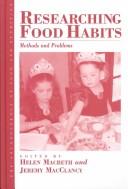| Listing 1 - 7 of 7 |
Sort by
|

ISBN: 1571815457 1782386122 Year: 2004 Publisher: New York (N.Y.): Berghahn
Abstract | Keywords | Export | Availability | Bookmark
 Loading...
Loading...Choose an application
- Reference Manager
- EndNote
- RefWorks (Direct export to RefWorks)
Multi
ISBN: 9780816539239 0816539235 9780816599738 0816599734 9781299192218 1299192211 9780816502363 Year: 2012 Publisher: University of Arizona Press
Abstract | Keywords | Export | Availability | Bookmark
 Loading...
Loading...Choose an application
- Reference Manager
- EndNote
- RefWorks (Direct export to RefWorks)
This volume brings together ethnographically based anthropological analyses of shifting meanings and representations associated with the foods, ingredients, and cooking practices that of marginalized and/or indigenous cultures. Contributors are particularly interested in how these foods intersect with politics, nationhood and governance, identity, authenticity, and conservation.
Book
ISBN: 3036551646 3036551638 Year: 2022 Publisher: MDPI - Multidisciplinary Digital Publishing Institute
Abstract | Keywords | Export | Availability | Bookmark
 Loading...
Loading...Choose an application
- Reference Manager
- EndNote
- RefWorks (Direct export to RefWorks)
The objective of this book is to present nutritional and educational interventions for children and their families. The creation of healthy preferences is a key determinant of food choices and therefore diet quality. Food choices have important implications for health, particularly for food-related diseases, such as feeding difficulties and the development of non-communicable diseases. The first years of a child's life are fundamental for the creation of tastes, eating habits and the relationship with food. Preferences for certain foods are neither innate nor unchangeable. Eating behaviour is the result of experience and learning, and, through the repeated offering of food by parents, especially those less accepted, it is possible to promote good nutrition. Behaviour depends on the interaction of environmental factors, genetics, sex, and age. The environment in which the child is immersed, and which influences them, includes family, other children, society, media and the supply of food. Achieving an adequate intake of macro and micro-nutrients is an important objective for all ages of life and, particularly, for those of pediatric age, since it is crucial for cognitive development. Nutrition has also a therapeutic effect. Nutritional interventions tailored to specific pathologies are needed to prevent nutritional deficiencies and maintain an adequate nutritional status, since children and adolescents with chronic or inflammatory diseases are particularly vulnerable and at major risk of developing malnutrition.
Medicine --- early food preferences --- feeding strategy --- dietary habits --- disease-related malnutrition --- educational intervention --- nutritional intervention --- obesity in childhood

ISBN: 2735110281 2735119378 9782735110285 Year: 2004 Volume: 19 Publisher: Paris: Maison des sciences de l'homme,
Abstract | Keywords | Export | Availability | Bookmark
 Loading...
Loading...Choose an application
- Reference Manager
- EndNote
- RefWorks (Direct export to RefWorks)
Arpenter les rues d'une « belle ville », exposer aux regards la « belle mécanique » d'une vieille voiture, partager entre amis un « beau souvenir » de vacances. La vie de tous les jours nous apporte les occasions les plus variées de mobiliser notre attention esthétique, de formuler des jugements de qualité. Mais que viennent sanctionner alors ces énonces esthétiques, dans ces circonstances qui ne les requièrent pas a priori ? Que faisons-nous, quelles relations tissons-nous avec les autres lorsque nous choisissons, fabriquons, « arrangeons » à notre goût les choses qui nous entourent ? Que dire de ce « goût » qui nous lie aux choses et aux gens ou qui, au contraire, nous en sépare et hiérarchise nos relations ? En se posant la question du « goût des belles choses » dans notre quotidien, les ethnologues rassemblent ici ont emprunté une autre voie que celles de la réflexion philosophique classique – centrée sur la définition d'une catégorie du beau – ou de la sociologie bourdieusienne – principalement intéressée par les fonctions sociales classificatrices du jugement de goût. C'est à partir d'exemples concrets – des films de famille au goût du vin, du hip-hop aux « beaux jardins » ou au cirque traditionnel – que les auteurs réunis dans cet ouvrage nous amènent à découvrir les multiples variations esthétiques des objets et des gestes qui constituent le cadre de notre vie quotidienne.
Ethnology. Cultural anthropology --- Aesthetics --- Esthétique --- Taste --- Ethno-anthropology --- The beautiful --- Philosophy --- Philosophy & Religion --- Esthétique --- Gustation --- Tasting (Physiology) --- Beautiful, The --- Beauty --- Esthetics --- Taste (Aesthetics) --- Chemical senses --- Drinking behavior --- Senses and sensation --- Tongue --- Food preferences --- Art --- Criticism --- Literature --- Proportion --- Symmetry --- Psychology --- Radio broadcasting Aesthetics
Book
ISBN: 0816539235 0816599734 1299192211 0816502366 Year: 2012 Publisher: University of Arizona Press
Abstract | Keywords | Export | Availability | Bookmark
 Loading...
Loading...Choose an application
- Reference Manager
- EndNote
- RefWorks (Direct export to RefWorks)
This volume brings together ethnographically based anthropological analyses of shifting meanings and representations associated with the foods, ingredients, and cooking practices that of marginalized and/or indigenous cultures. Contributors are particularly interested in how these foods intersect with politics, nationhood and governance, identity, authenticity, and conservation.
Food habits. --- Food preferences. --- Food supply. --- Food control --- Produce trade --- Agriculture --- Food security --- Single cell proteins --- Food selection --- Food habits --- Nutrition --- Taste --- Eating --- Food customs --- Foodways --- Human beings --- Habit --- Manners and customs --- Diet --- Oral habits --- Psychological aspects --- Anthropology --- foodways --- globalization --- culinary tourism --- indigenous food --- cultural studies --- anthropology --- sociology --- global studies --- ethnography --- food
Book
Year: 2022 Publisher: Basel MDPI Books
Abstract | Keywords | Export | Availability | Bookmark
 Loading...
Loading...Choose an application
- Reference Manager
- EndNote
- RefWorks (Direct export to RefWorks)
As Severe Acute Respiratory Syndrome Coronavirus-2 (SARS-CoV-2) evolved into a global pandemic, assessments of coronavirus disease 19 (COVID-19) patients have presented health conditions including, in many cases, a mild to severe loss of smell and tasting abilities among patients. Initial work has shown short and likely longer term negative effects on the human senses, with some indications of effects on consumer preferences; however, as of yet, very little is known about the impacts on eating behaviours and consequent longer term effects on appetite. The aim of this Special Issue anthology was, for the first time, to bring together researchers with key insights into how COVID-19 has impacted appetite and eating behaviours from the fundamental to the applicable, as assessed by human sensory perception. Thus, research is included that explores various themes, from the basic effects on the senses, to changes in consumer preferences, all the way to how and why COVID-19 has changed consumer behaviours in relation to food and eating in the longer term. Overall, we wished to document and bring together key research in the sensory and consumer space with respect to COVID-19, with the overall aim to highlight and ensure this research has a lasting impact regarding future understandings of measures developed to help and treat people affected during the ongoing pandemic.
lockdown --- COVID-19 --- coronavirus --- food choice --- food purchase --- food waste --- impulse buying --- food consumption --- mental health --- emotional eating --- sensory function --- chemosensory dysfunction --- perception --- appetite --- well-being --- pleasure --- recovery --- interview --- sensory perception --- eating behaviour --- self-reports --- food prices --- Eurozone --- Holt–Winters model --- green food --- purchase intention --- TPB --- E-TPB --- Chinese consumer --- consumer preference --- COVID-19 lockdown --- food preferences --- risk preference --- risk perceptions --- food purchasing behavior --- food consumption behavior --- sustainable behavior --- dietary behavior --- beverage consumption --- coffee --- tea --- online food delivery service --- COVID-19 pandemic --- technology acceptance --- trust --- enjoyment --- social influence --- young population --- food perception --- risk perception --- food safety --- Belgium --- consumer behaviour --- food service sector --- safety measures --- transparency --- olfactory distortions --- parosmia --- trigger foods --- disgust --- valence --- n/a --- Holt-Winters model
Book
Year: 2020 Publisher: Basel, Switzerland MDPI - Multidisciplinary Digital Publishing Institute
Abstract | Keywords | Export | Availability | Bookmark
 Loading...
Loading...Choose an application
- Reference Manager
- EndNote
- RefWorks (Direct export to RefWorks)
The sensation of flavor reflects the complex integration of aroma, taste, texture, and chemesthetic (oral and nasal irritation cues) from a food or food component. Flavor is a major determinant of food palatability—the extent to which a food is accepted or rejected—and can profoundly influence diet selection, nutrition, and health. Despite recent progress, gaps in knowledge still remain regarding how taste and flavor cues are detected at the periphery, conveyed by the brainstem to higher cortical levels, and then interpreted as a conscious sensation. Taste signals are also projected to central feeding centers where they can regulate hunger and fullness. Individual differences in sensory perceptions are also well known and can arise from genetic variation, environmental causes, or a variety of metabolic diseases, such as obesity, metabolic syndrome, and cancer. Genetic taste/smell variation could predispose individuals to these same diseases. Recent findings have opened new avenues of inquiry, suggesting that fatty acids and carbohydrates may provide nutrient-specific signals informing the gut and brain of the nature of the ingested nutrients. This Special Issue, Taste, Nutrition, and Health, presents original research communications and comprehensive reviews on topics of broad interest to researchers and educators in sensory science, nutrition, physiology, public health, and health care.
acceptability --- food development --- sensory attributes --- CATA --- dietotherapy --- aromas --- linoleic acid --- gustation --- hedonic --- BDNF --- fat taste --- c-Fos --- Zif-268 --- Glut-1 --- sweeteners --- sugar reduction --- psychophysical dose-response --- sweetness growth rate --- sweetness potency --- cross-cultural --- food liking --- sensory --- questionnaire --- fMRI --- caffeine --- taste --- memory --- sensory evaluation --- tea --- EGCG --- hedonics --- sweet taste --- psychophysics --- nutrition --- diet --- threshold --- intensity --- liking --- sweetness --- taste test --- individual differences --- classification method --- taste perception --- umami --- carbohydrate --- sweet --- salt --- bitter --- physical activity --- basic tastes --- taste reception --- smell --- dysgeusia --- burning sensation --- halitosis --- saliva --- caries --- primary Sjögren’s syndrome --- non-SS sicca syndrome --- sweet liking --- fat liking --- e-cigarettes --- body mass index --- dietary behaviors --- tobacco --- cigarettes --- chronic smoking --- electrophysiological recording from human tongue --- fat perception --- CD36 --- PROP tasting --- grapefruit --- consumer --- naringin --- aroma --- color --- satiety --- tastants --- food intake --- intraduodenal infusion --- intraileal infusion --- overweight --- weight management --- Obesity --- eating behavior --- prebiotics --- microbiota --- sex differences --- biopsychosocial --- children --- brain imaging --- smell sensitivity --- olfaction --- staircase --- QUEST --- choice --- familiarity --- PROP --- food neophobia --- sensitivity to disgust --- sensitivity to punishment --- vegetables --- caffeinated beverages --- bitterness --- astringency --- taste preference questionnaire --- validation --- European children --- adolescents --- adults --- genetics --- food preferences --- heritability --- candidate gene --- GWAS --- adiposity --- polygenic risk score --- n/a --- primary Sjögren's syndrome
| Listing 1 - 7 of 7 |
Sort by
|

 Search
Search Feedback
Feedback About UniCat
About UniCat  Help
Help News
News